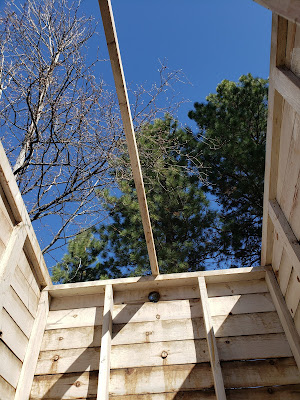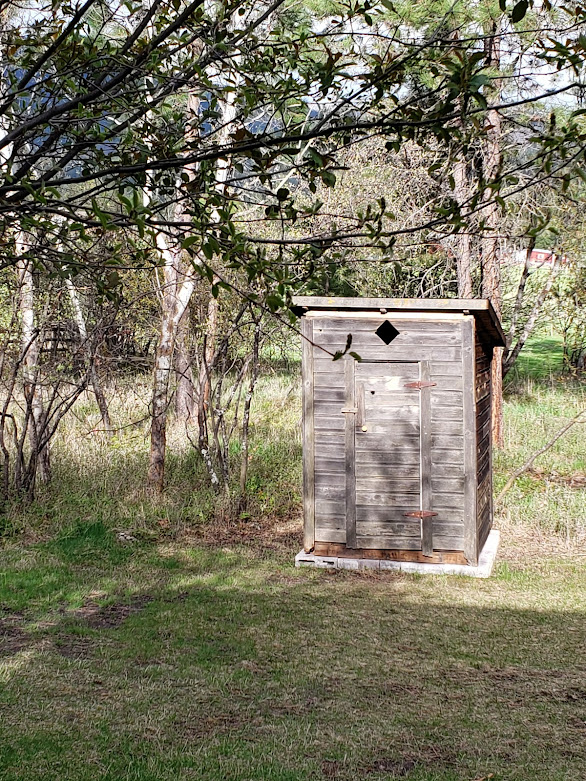Like everyone else, this whole coronavirus/COVID-19/pandemic thing has been life-altering. I mean none of us have ever dealt with anything like this before, especially on a worldwide basis. Having said that, it hasn’t been without its silver linings.
When the world got the lockdown order, we had to figure out how to live, how to associate with others, how to work and even how to worship at home. For work, I spent my first week or so sprawled out on the couch with my laptop sitting on my legs before eventually incorporating a second screen and taking over half of the dining room table. It was comfortable and even awesome to wear a t-shirt, shorts and slippers while stoking the fire burning in the fireplace. And if I got hungry, the refrigerator was a mere 8-10 paces away (which really isn’t a good thing).
 |
| The home set-up |
On the downside, working at home meant I had to use our WIFI, or should I saw our lack of any kind of decent or reliable Internet due to our somewhat remote location in the woods. I soon learned I had to plan out my day so I’m not sitting and staring at a little circle that spins round and round on my computer screen as I try to send out mass work-related emails. One grouping in particular has more than 500 people in it. Even using a hotspot supplied by my employer, it would take 45 minutes for that email to reach all 500 of its recipients so I would work on daily duties until then and send it right before taking a break for lunch. At that point, I would hit “send,” and then eat and then wait until it finished going out. Frustrating? Yeah, but what are you really going to do? (I returned to the office after four weeks or so and we since installed a satellite Internet system which is better but still not high speed like at work.)
When I returned to the office, the entire workplace was (and remains) like a ghost town. I am the only person in my whole corner of the building. There are somewhere between eight to 20 cars in the parking lot on a daily basis. And all of my team members continue to work from their individual homes. We remain productive and effective working remotely. We communicate via email, text, Slack and/or Zoom virtual meetings.
Worshiping remotely has been well, unique. You see, I’ve always been a believer and a church-goer. Sundays my whole life have been like this: get up as a family, go to church as a family, spend the day together as a family and take part in other church-related gatherings. COVID-19 meant no group gatherings, no group worship, nothing. Well, I shouldn’t say “nothing.” Church members continue to worship but we do so as families and remotely. My wife and I read and study scriptures on Sundays, which we actually do every night before we go to bed. Our stake (a group of local congregations stretching from the edge of Missoula, west to Frenchtown, north to the Mission Valley and further north and west to Thompson Falls, provided a weekly 35-minute online worship service. It was (and remains) nice to see friends from across western Montana. Pre-edited programs consist of someone conducting from their home, a song provided by the Tabernacle Choir , and then an opening prayer, a couple of talks on various gospel subjects, another Tabernacle Choir song and a closing prayer to wrap things up. All in all, it’s been nice to continue to learn and grow even though we cannot meet together.
Worshiping remotely has been well, unique. You see, I’ve always been a believer and a church-goer. Sundays my whole life have been like this: get up as a family, go to church as a family, spend the day together as a family and take part in other church-related gatherings. COVID-19 meant no group gatherings, no group worship, nothing. Well, I shouldn’t say “nothing.” Church members continue to worship but we do so as families and remotely. My wife and I read and study scriptures on Sundays, which we actually do every night before we go to bed. Our stake (a group of local congregations stretching from the edge of Missoula, west to Frenchtown, north to the Mission Valley and further north and west to Thompson Falls, provided a weekly 35-minute online worship service. It was (and remains) nice to see friends from across western Montana. Pre-edited programs consist of someone conducting from their home, a song provided by the Tabernacle Choir , and then an opening prayer, a couple of talks on various gospel subjects, another Tabernacle Choir song and a closing prayer to wrap things up. All in all, it’s been nice to continue to learn and grow even though we cannot meet together.
 |
| Dress up for Sunday's online church service? Sure, why not. |
An additional silver lining remains family time. While my daughter and her family live a mere 100 yards off our back property line, we’ve spent even more time together. More dinners, more play time and more bonding. Another daughter moved in with us from out-of-state during the pandemic with her family. It has been great having them here, playing with them and having their two boys with us as they develop deep ties with their three cousins out back.
So here we are (five months as of this post). Stay-at-home lockdown orders are mostly over everywhere but our workplace still remains rather vacant with the majority of staff working at home. Our churches remain shuttered. Who knows when things will return to “normal?” Heck, who knows what the “new normal” will turn out to be? All I know is life may be different (aka very different) but silver linings abound. All you need to do is look for, recognize and take advantage of them. That’s what we’re trying to do.












































